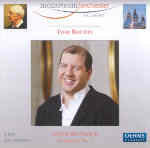There was a time when this symphony was a rarity, the exclusive preserve of Bruckner specialists who even then approached it with trepidation, committing their interpretations to disc only after much thought and plenty of preparation in the form of the other, more popular symphonies. They had good reason: this is the most peculiar, the most difficult Bruckner symphony for both the conductor and the players. It offers huge challenges to the orchestra’s endurance, and requires a vision in which the man with the stick knows exactly where the music wants to go and how every passage relates to the whole. It is certainly not music to be taken lightly. While I wouldn’t accuse Ivor Bolton of that, “lightly” is how this performance comes off, to the point of vapidity, and it’s not just a function of the somewhat monochrome, hollow-sounding engineering.
Certainly Bolton understands the basics. He knows the difference between allegro and adagio in the first movement and wisely (given what he has to work with) adopts relatively fleet tempos in the inner movements. He also tries to build the finale to a satisfying final peroration. But therein lies the problem. The orchestra, with its undernourished strings, tinny brass, and overbearing timpani, sounds unbalanced and overmatched, with the result that any suggestion of the music’s true grandeur appears almost laughable. Adding insult to injury, Bolton’s club-footed handling of the final chorale struggles vainly against his flaccid phrasing to achieve even the slightest feeling of apotheosis. He just doesn’t grasp the vision. The finale’s central double fugue passes by in a blur of tensionless counterpoint, and there’s no sense in even discussing the first three movements, since they dribble along without anything noteworthy happening at all. Given the competition, it was a ludicrous idea to preserve this performance, which shows little beyond the fact that provincial orchestras can deliver provincial renditions of this symphony largely free of gross errors in execution. Well, now we know.
































